Title |
| Curating Online Exhibitions – Part 1: Performance, variability, objecthood |
Author |
| Michael Connor |
Year |
| 2020 |
Publisher |
| Rhizome |
Description |
| With physical exhibitions around the world now closed as a result of the COVID-19 pandemic, institutions and artists now face questions about online exhibition-making with sudden urgency. The task might at first seem relatively straightforward: to provide a point of access for the general public to programs and information that would otherwise be experienced in person. [...] |
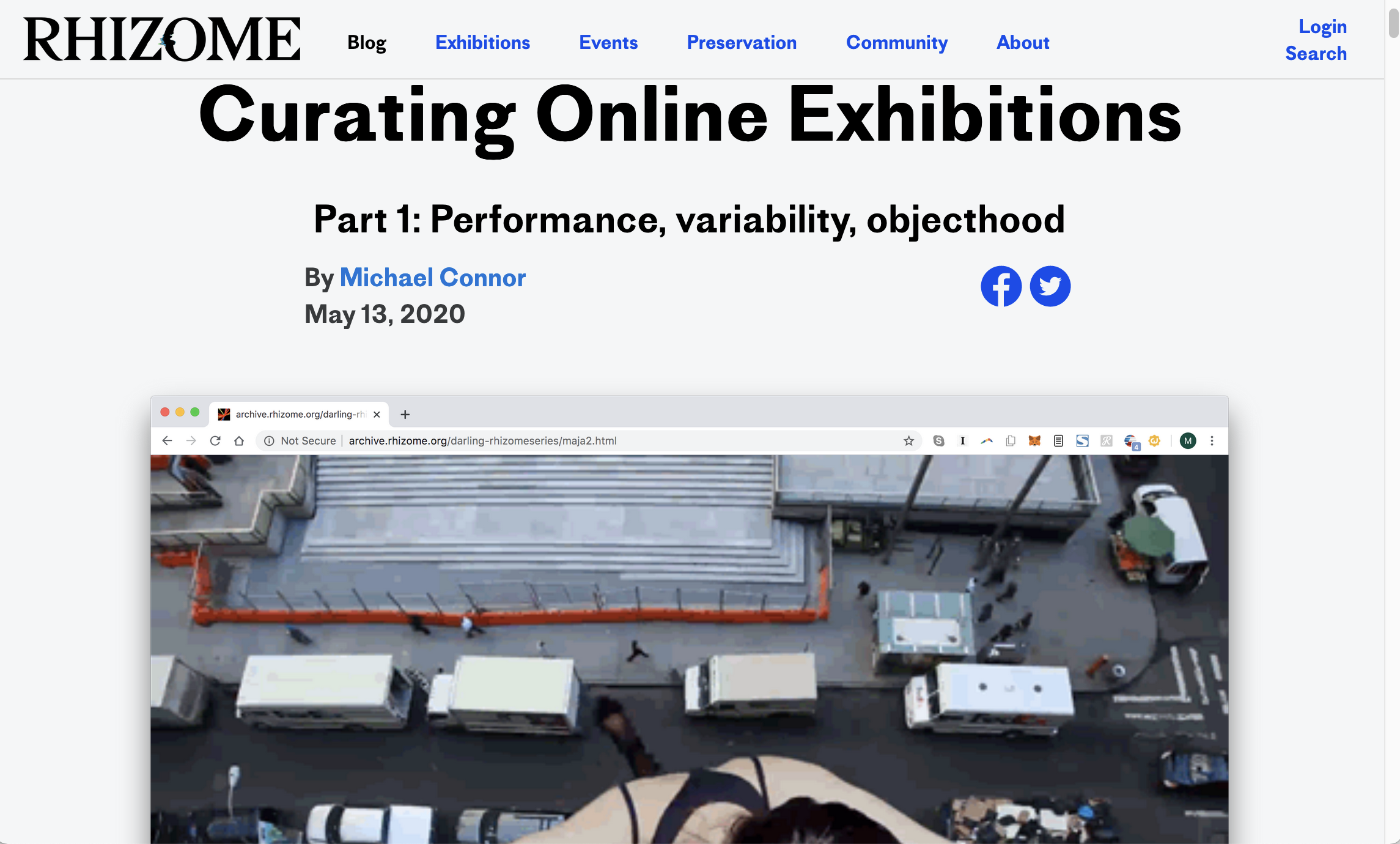 |
url |
| https://rhizome.org/editorial/2020/may/13/curating-online-exhibitions-pt-1/ |
Title |
| Curating the Networked Image: Circulation, Commodification, Computation |
Author |
| Gaia Tedone |
Year |
| 2019 |
Publisher |
| The Centre for the Study of the Networked Image, London South Bank University, UK |
Description |
| In the context of today’s networked culture, where artworks and photographs circulate online alongside other commodities and digital objects, online users and data aggregation tools partake in the selection, filtering and dissemination of visual content. The conflict of differentiation emerging from within the shared space of the Internet is at once aesthetic, social and political. At the core of this research is the question of how the curation of networked images can produce cultural value and social meaning in the face of such a conflation of interests and agendas. The study argues for the necessity to reconsider the conventional paradigm of art curating in light of these shifting conditions and in response to the emergent discipline of digital curation, and it repositions the role of the curator and the work of networked images within this accelerated and evolving field. |
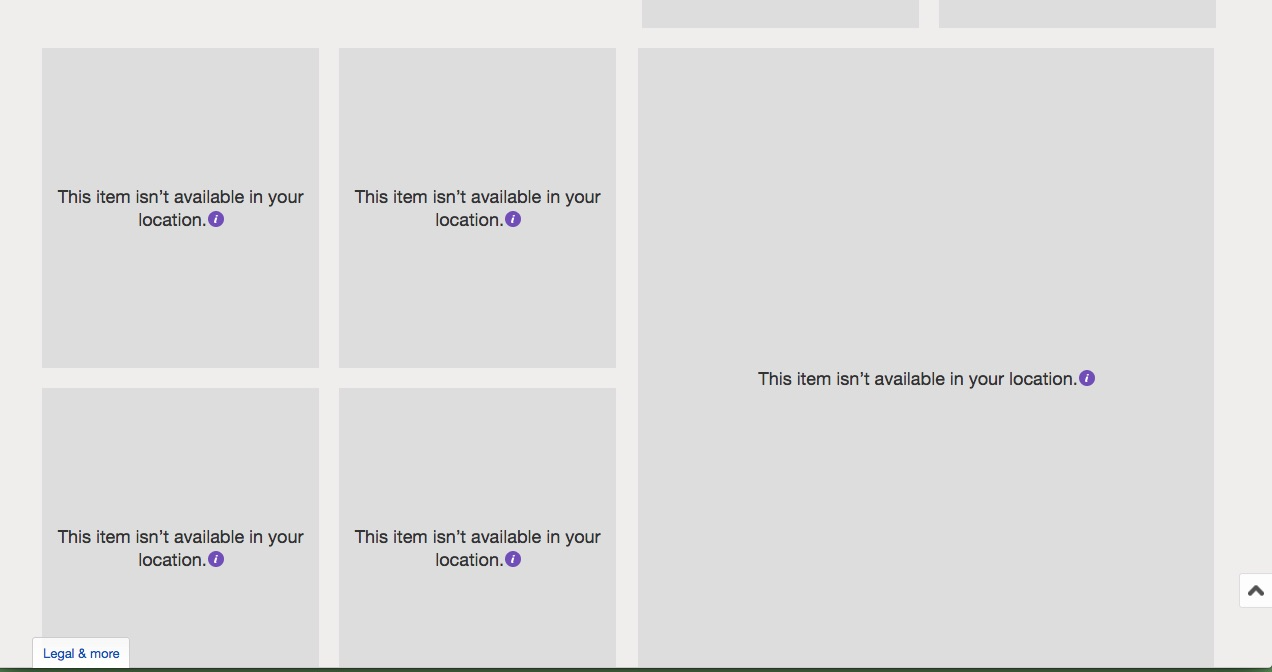 |
Title |
| Curating Web-Based Art Exhibitions: Mapping Online and Offline Formats of Display |
Author |
| Marialaura Ghidini |
Year |
| 2015 |
Publisher |
| University of Sunderland |
Description |
| This dissertation investigates the theory and praxis of curating web-based exhibitions from the perspective of a practitioner (the author Marialaura Ghidini). Specifically, it investigates how the web as a medium of production, display, distribution and critique has had an impact on the work and research of independent curators and the way in which they configure their exhibition projects. With a focus on the last decade, curatorial work of production and commission is considered in relation to technological developments, previous theoretical work into the mapping of exhibitions online and the analysis of case studies which are paralleled with the author’s own exhibition projects. What has emerged from this combination of theory, practice and comparison of approaches is the rise of a tendency in contemporary curatorial practices online: the creation of exhibitions that migrate across sites—online and offline—and integrate different components—formats of display and distribution—giving life to exhibition models which this study names as those of the 'extended' and 'expanded'. The figure of the curator as mediating ‘node’ is another characteristic emerging in relation to this tendency. Its features are identified through the observation of six case studies, which include Beam Me Up, CuratingYouTube and eBayaday, and interviews with their curators, and three projects that the author organised with the web curatorial platform or-bits-dot-com, "128kbps objects" (2012), "(On) Accordance" (2012) and "On the Upgrade WYSIWG" (2013), which experiment with modes of integrating web-based exhibition with other exhibition formats, such as the gallery show and print publishing. Through combining contextual review and curatorial practice, this study names the tensions existing between online and offline sites of display and modes of production and commission, offering critical and practical ground work to discuss the tendency of migrating exhibitions and integrating formats within the larger context of curating contemporary art. |
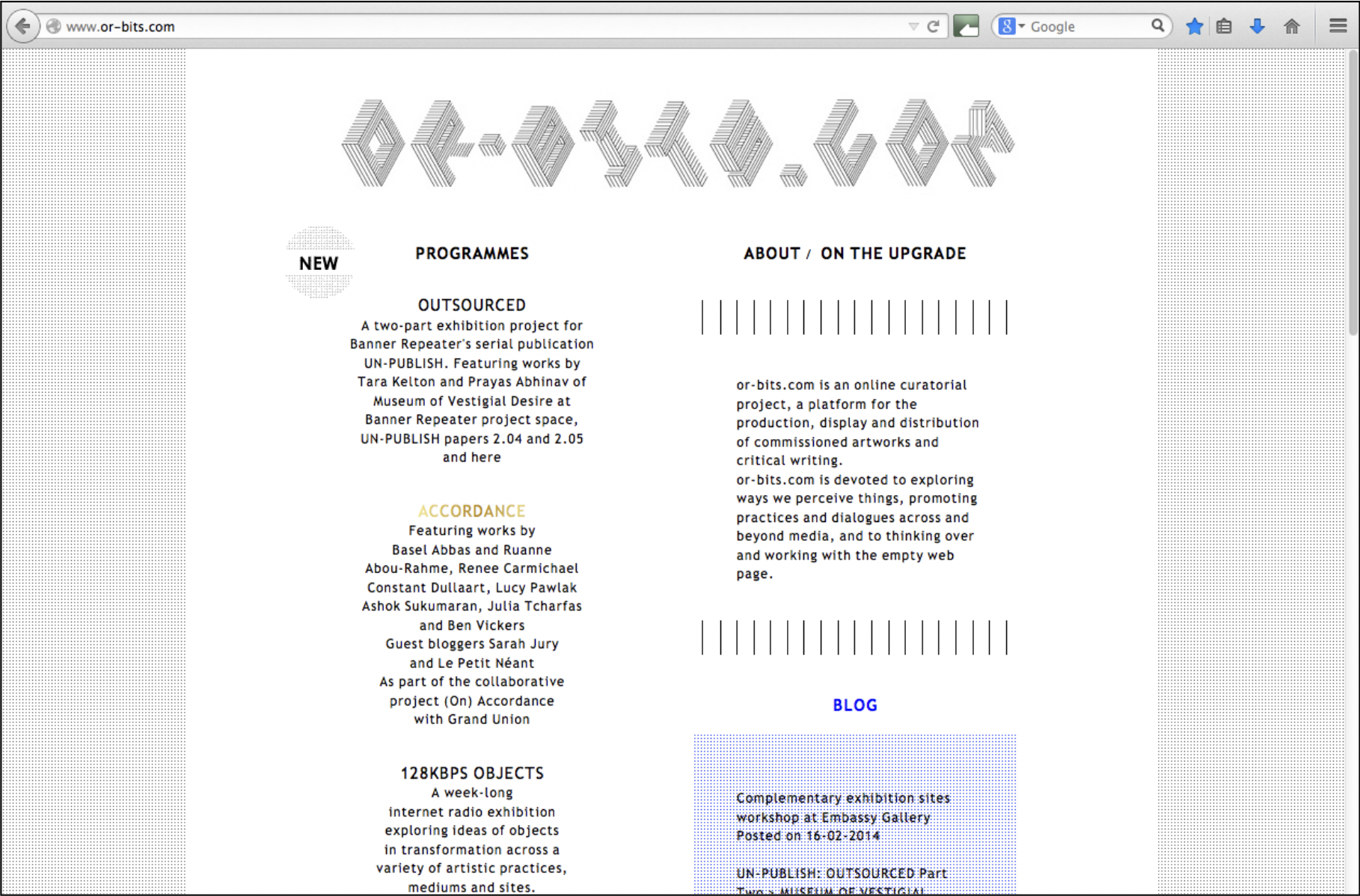 |
url |
| https://sure.sunderland.ac.uk/id/eprint/6088/ |
Title |
| Curating with the Internet |
Author |
| Sean Lowry |
Year |
| 2018 |
Publisher |
| Wiley Blackwell |
Description |
| This chapter explores Internet-based and Internet-activated approaches to curating art through both established and nontraditional exhibition circuits. Today, new curatorial approaches are emerging in tandem with digitally activated modes of presentation and dissemination distinguished by perpetual reproducibility, multiple intersecting temporalities and materializations, and the subsidence of physical space. Accordingly, this chapter discusses networked, distributed, and modular approaches that variously disrupt, democratize, antagonize, institutionalize – and in some cases altogether bypass – the figure of the curator. Significantly, many of these approaches are no longer necessarily connected to singular events or spaces and are perhaps better understood as omnidirectional movements between modes of conception, production, and dissemination connected through the screen as a communal space. This communal space might offer either access to new works, illuminate the existence of works understood to be elsewhere in time and space, or offer multiple or alternative materializations, versions, attributions, interpretations, and representations of existing works. Published in: A Companion to Curation by Buckley, B. and Conomos, J. |
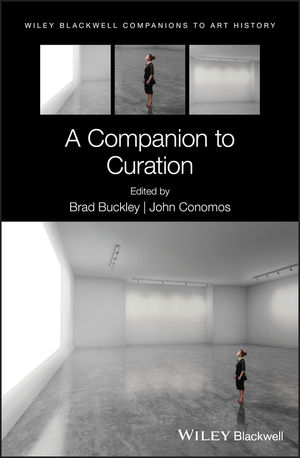 |
url |
| https://www.academia.edu/42023711/Curating_with_the_Internet |
Title |
| Curation and its Statistical Automation by means of Artificial ‘Intelligence’ |
Author |
| Francis Hunger |
Year |
| 2021 |
Publisher |
| Training the Archive (Ed.), Aachen/Dortmund |
Description |
| The concept of post-AI curating discussed in this Working Paper explores curation as a knowledge-creation process, supported by Pattern Recognition and weighted networks as technical tools of artificial ‘intelligence’. The text discusses a number of concepts that build on each other, such as curating, curator, the curatorial, curatorial experimental research, post-human curating and post-AI curating. It then examines several projects as case studies that approach curation using artificial ‘intelligence’: The Next Biennial Should Be Curated by a Machine from UBERMORGEN, Leonardo Impett and Joasia Krysa (2021) as a meta-artwork about curation and biennials; Tillmann Ohm’s project Artificial Curator (2020), which resulted in an automatically curated exhibition; and #Exstrange by Rebekah Modrak and Marialaura Ghidini et. al. (2017), which presents artworks as data objects on the eBay online platform. Finally the text shifts to summarising embeddedness, big data infrastructures, spatiality and information model, solutionism and Digital Humanities, selection and similarity as instances of post-AI curating. |
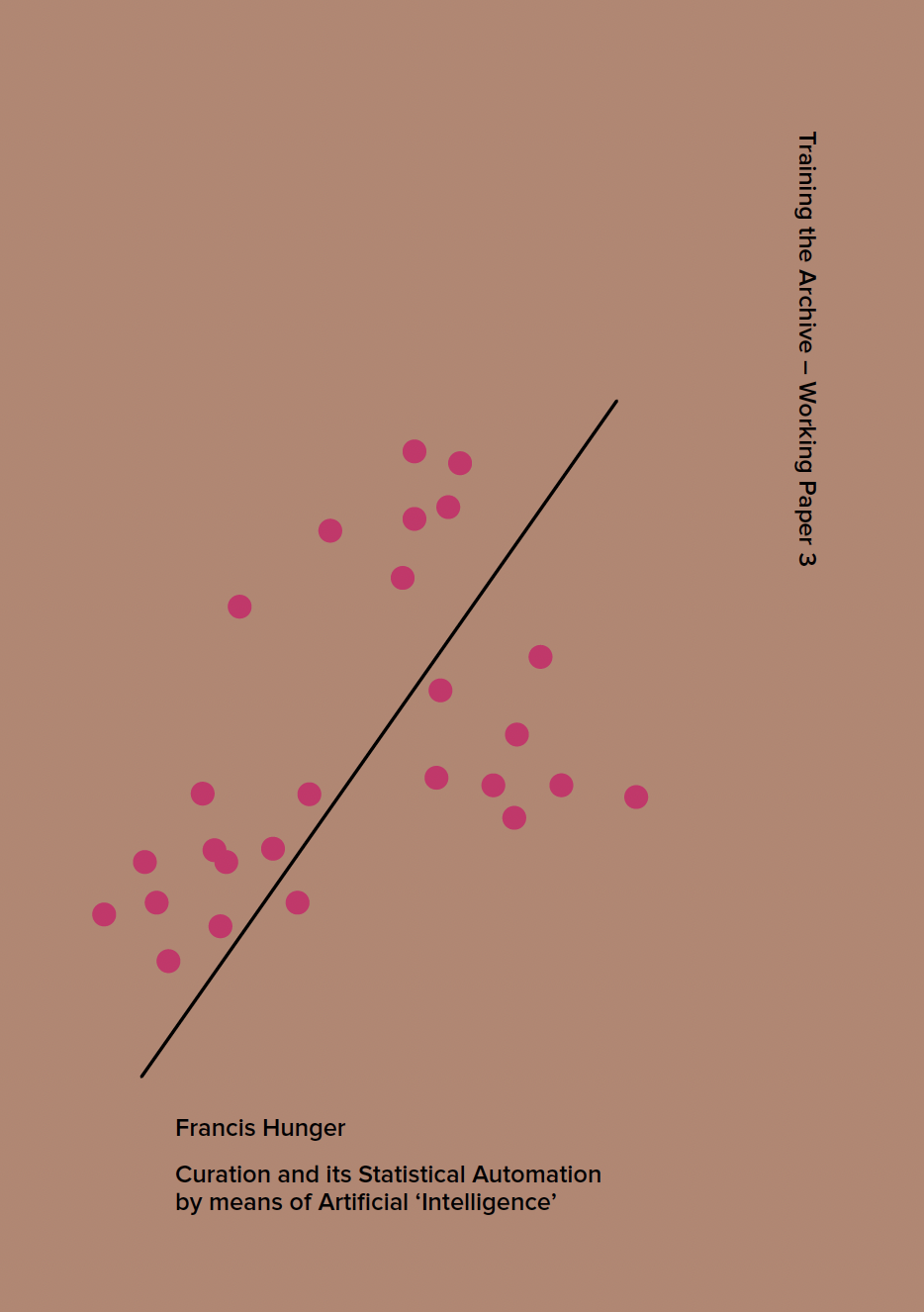 |
url |
| https://trainingthearchive.ludwigforum.de/en/working-paper-3-en/ |
Title |
| DATA browser 03 – Curating Immateriality: The Work Of The Curator In The Age Of Network Systems |
Author |
| Joasia Krysa |
Year |
| 2006 |
Publisher |
| Autonomedia |
Description |
| The site of curatorial production has been expanded to include the space of the Internet and the focus of curatorial attention has been extended from the object to processes to dynamic network systems. As a result, curatorial work has become more widely distributed between multiple agents, including technological networks and software. This upgraded 'operating system' of art presents new possibilities of online curating that is collective and distributed - even to the extreme of a self-organising system that curates itself. The curator is part of this entire system but not central to it. The subtitle of the book makes reference to the essay 'The Work of Culture in the Age of Cybernetic Systems' (1988), in which Bill Nichols considered how cybernetics transformed cultural production. He emphasised the shift from mechanical reproduction (symbolised by the camera) to that of cybernetic systems (symbolised by the computer) in relation to the political economy, and pointed to contradictory tendencies inherent in these systems: 'the negative, currently dominant, tendency toward control, and the positive, more latent potential toward collectivity'. The book continues this general line of inquiry in relation to curating, and extends it by considering how power relations and control are expressed in the context of network systems and immateriality. In relation to network systems, the emphasis remains on the democratic potential of technological change but also the emergence of what appears as more intensive forms of control. Can the same be said of curating in the context of distributed forms? If so, what does this imply for software curating beyond the rhetoric of free software and open systems? |
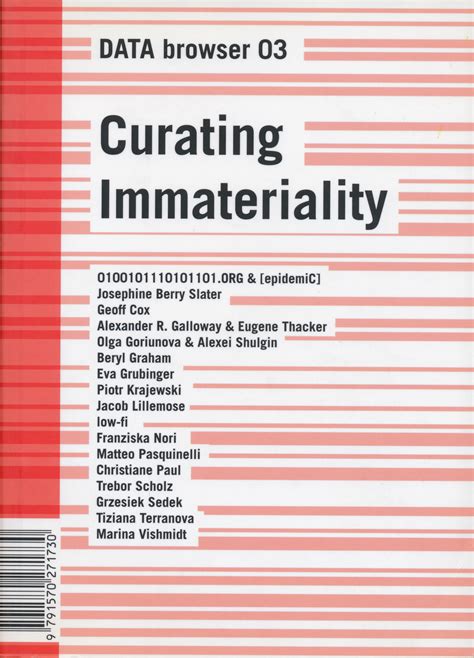 |
url |
| [:en]http://data-browser.net/db03.html[:] |
Title |
| Do we need buildings for digital art? |
Author |
| Rob Allen |
Year |
| 2013 |
Publisher |
| The Guardian |
Description |
| With the rise of online curation, is digital practice becoming less dependent on the bricks and mortar of an exhibition space? |
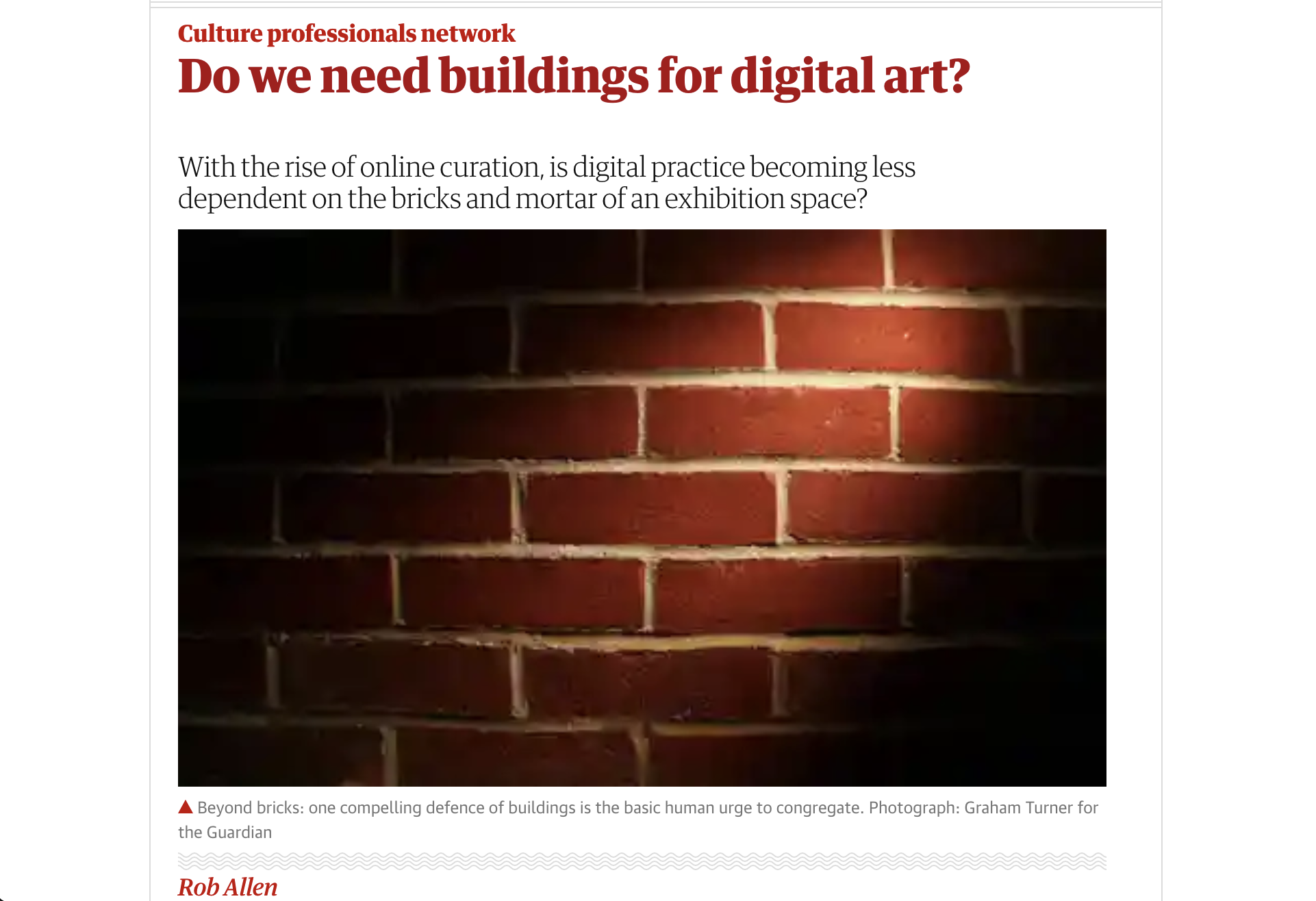 |
url |
| https://www.theguardian.com/culture-professionals-network/culture-professionals-blog/2013/jul/19/does-digital-art-need-buildings#start-of-comments |
Title |
| Experiments in (Social) Software Curating: Reprogramming Curatorial Practice for Network |
Author |
| Joasia Krysa |
Year |
| 2008 |
Publisher |
| Vague Terrain |
Description |
| The paper addresses the issue of new developments in the field of curating in the context of information technologies. It explores the emergence of an interdisciplinary approach that directly links the field of curating with computer programming and a relatively recent interest in software art. Although there is much contemporary critical work and practice that is described as art-oriented programming or software art, the paper responds to a perceived gap in discussions about software curating. It is important to emphasise that in this context software curating is not to be understood as the activity of curating software art works (in other words the activity of bringing software artworks into public domain) but as integrating software and programming in the curatorial process per se. Furthermore, the paper reflects upon the recent rise of popularity of social technologies and their relevance for curating. The underlying suggestion is that curating responds to this by developing new forms that increasingly involving socio-technological networks and that can be characterised as socially driven and distributed over networks. |
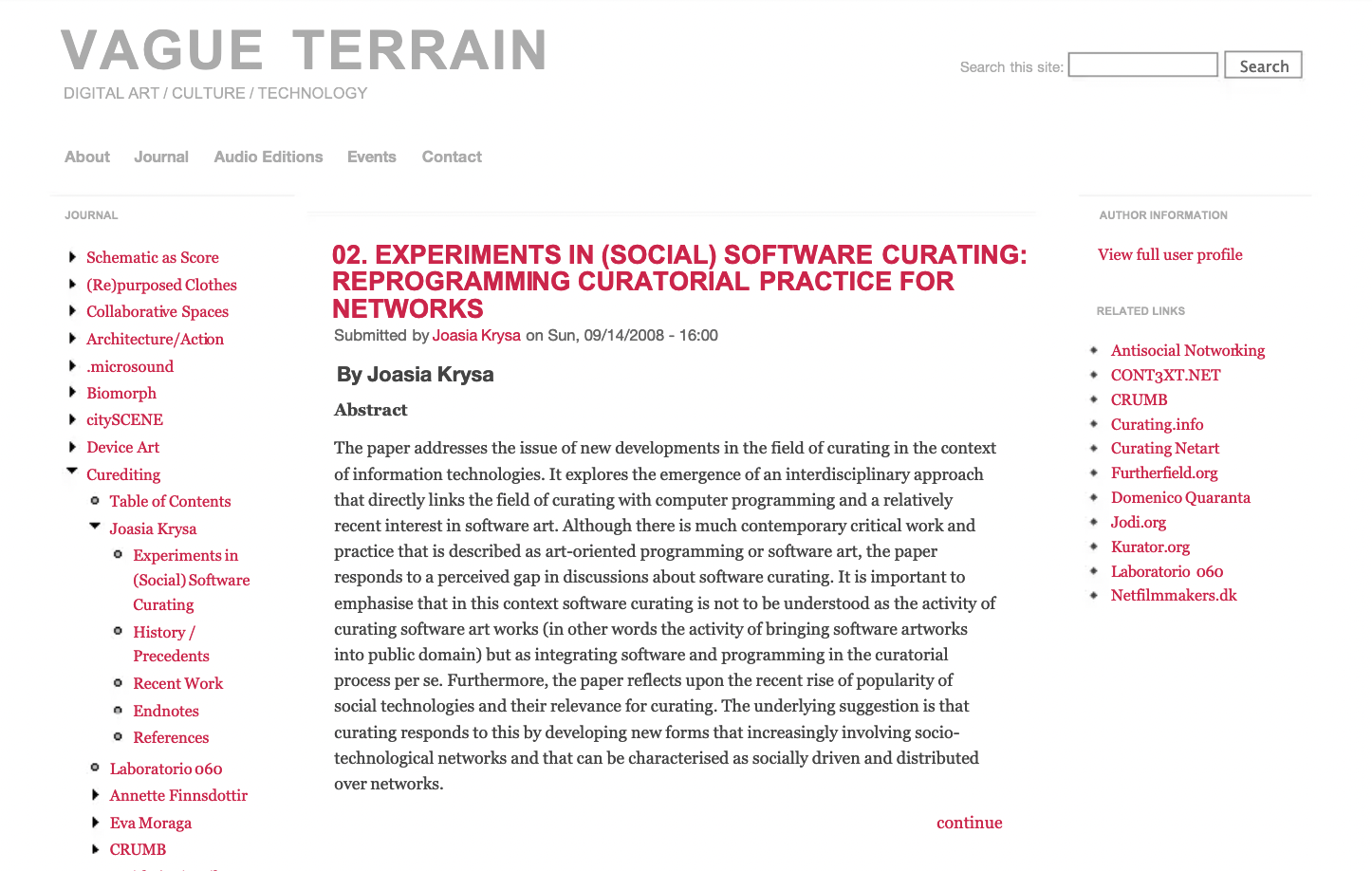 |
Title |
| Internet art [net art] |
Author |
| Sarah Cook, Marialaura Ghidini |
Year |
| 2015 |
Publisher |
| Grove Art Online, Oxford University Press, UK |
Description |
| Dictionary entry about art that uses the Internet not only as its tool of production and distribution but also as its source material or medium, and exploits or reflects the Internet’s inherently connective characteristics |
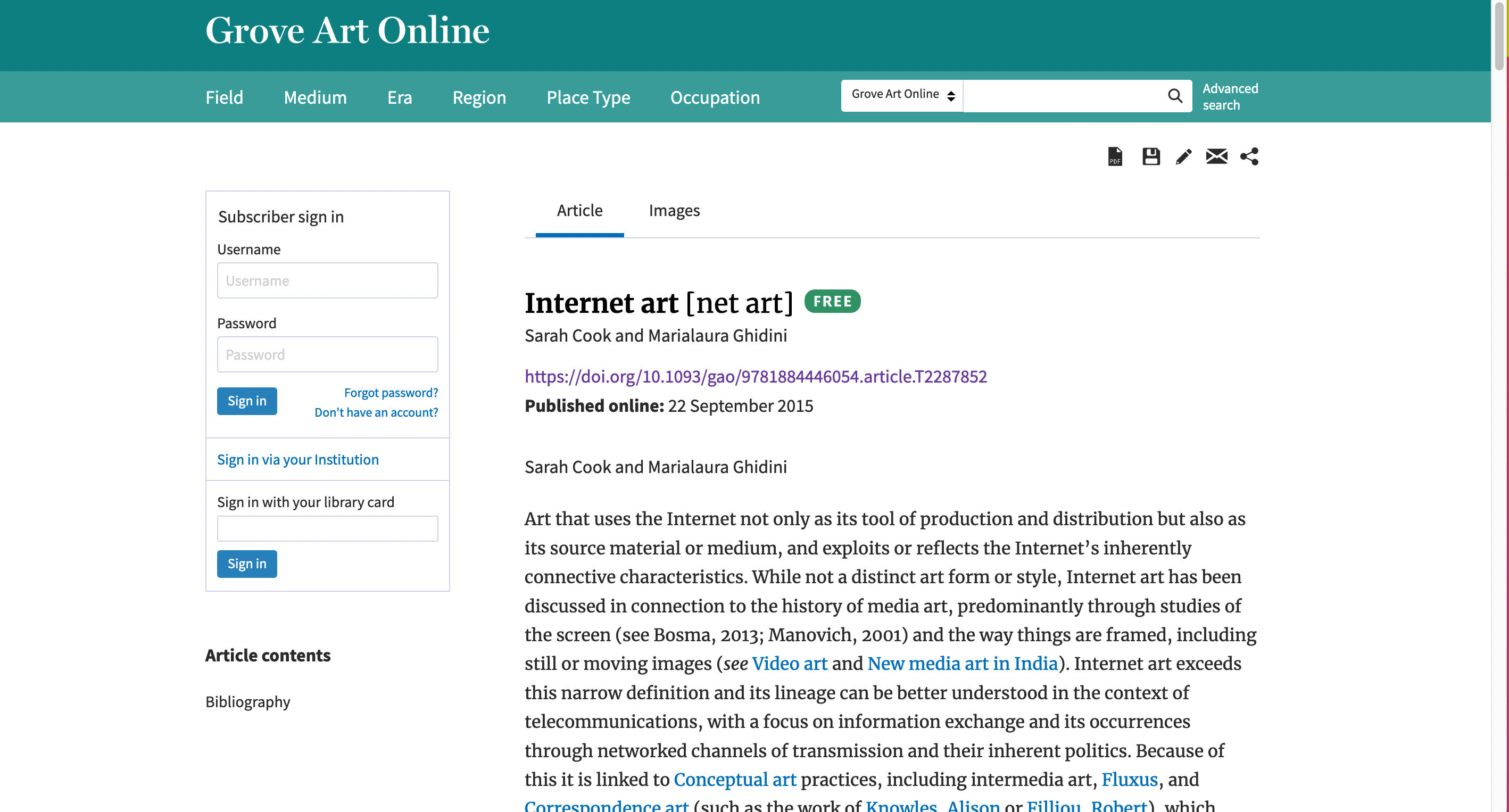 |
url |
| https://doi.org/10.1093/gao/9781884446054.article.T2287852 |
Title |
| Investigations on the Cultural Economy of Media Art |
Author |
| Alessio Chierico |
Year |
| 2017 |
Publisher |
| Digicult Editions |
Description |
| “Investigations on the Cultural Economy of Media Art” is a collection of the heterogeneous perspectives that are contributing to the current discussion about the economies of the Media Art field. Acknowledging the needs of the art market and its role in the commodification and validation of art practices, this book expands its gaze to the whole setting of the art economy. Addressing the issues of conservation and distribution, as well as many other aspects impacting on this sector, a special emphasis is put on new innovative and critical models. AUTHORS INCLUDED: Paolo Cirio, Annette Doms, Vincenzo Estremo, Steve Fletcher, Marialaura Ghidini, Wolf Lieser, Jonas Lund, Rafael Lozano-Hemmer, Marco Mancuso, Rebekah Modrak, Christiane Paul, Domenico Quaranta, Christa Sommerer and Laurent Mignonneau, Gerfried Stocker, Pau Waelder |
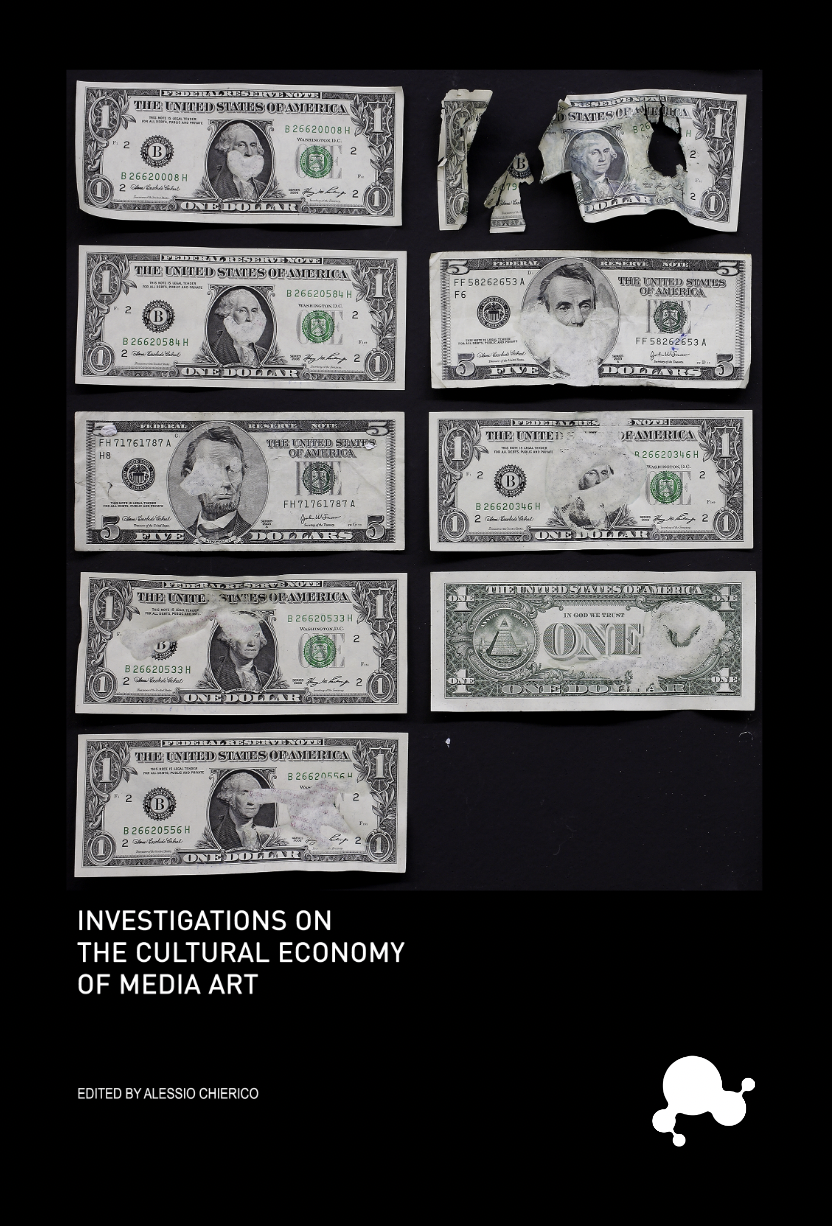 |
url |
| https://www.digicult.it/wp-content/uploads/TheCulturalEconomyOfMediaArt.pdf |